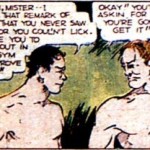by Kevin Zelnio

#18 Actinoscyphia spp. (Phylum: Cnidaria, Class: Anthozoa, Order: Actiniaria, Family: Actinoscyphiidae)
Like its namesake, the "venus fly trap" anemone resembles the plant that snatches up the unsuspecting critter that wanders across its tentacles. Though described in 1920 we are still unclear how many species of Actinoscyphiidae exist. We find them in every ocean basin attached to rocks, stems of corals, tubeworm tubes, shipwrecks, deep sea litter and any other hard substrate. Not every species in the family Actinoscyphiidae looks like a fly trap anemone though. The fly trap anemone is truly unique among anemones, though most anemones are passive predators. That is, the stand around with their beautifully flowing tentacles wavering in the current, waiting for a morsel, perhaps a small fishy meal or a tasty crustaceous snack, to unknowingly drift close enough to the patiently awaiting grasp of the muscular, stinging tentacles trained over millions of years to react in a split second to the slightest of pertubations. Elegant.
Video from NOAA Ocean Explorer!
- #27: Brachiopods
- #26: Pig Butt Worm
- #25: Crawling Crinoids
- #24: Tube Worms
- #23: Dumbo Octopus
- #22: Xenophyophores
- #21: Phronima
- #20: Swimming Sea Cucumbers
- #19: Black Devil Anglerfish







I’m not positive, but I believe the anemone on the left, from Davidson Seamount, is in the family Hormathidae, rather then Actinoscyphiidae. Equally cool, either way. Some sources say they are detrictus feeders, but that doesn’t make sense, given their morphology, which seems designed for capturing active prey…
dobhran, i’d never admit to being an expert in anything but I’ve worked extensively with some anemones. I have 4 described with colleagues which you’ll hear more about when that paper is published. I think the Hormithiidae designation was wrong and that it is actually in the Actinoscyphiidae. Also, there was a little confusion (historically) of whether actinoscyphiids are actually Actinostolidae, but several very recent papers firmly establish the Actinoscyphiidae cladistically with morphological characters. This is also supported using nuclear and mitochondrial genes.
Regarding detritus feeding, it is unlikely. In fact, anemones are very much passive predators, hence the need for stinging cells. There is research showing that anemones can take up Dissolved Organic Carbon through their cell membranes and that is does constitute a proportion of their food intake, albeit a much smaller proportion compared to carnivory. Good questions and comments!
What type of proportions are being discussed for direct cellular DOC uptake?
In this reference: Schlichter D. 1982. Nutritional Strategies of Cnidarians – the Absorption, Translocation and Utilization of Dissolved Nutrients by Heteroxenia-Fuscescens. American Zoologist 22:659-669.
In Heteroxenia fuscescens “the uptake of only 12 amino acids and glucose, experimentally determined, approximately 80% of the energy demand can be covered, the contribution of algal products not included.”